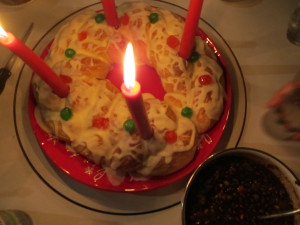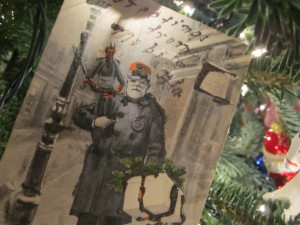By now, the 13th of December, the Northern Hemisphere is well cloaked in the darkness of winter. The solstice, that turning point when the sun shifts from waning to strengthening, is, this year, still eight days away. And so enters St. Lucy, Santa Lucia, whose name comes from light: lux and lucis, the Latin words for light. Her feast day is today, the 13th of December. Centuries ago, before the Gregorian reform of the calendar, her day used to coincide with the Winter Solstice, so the connections between Santa Lucia and light overcoming dark are profound and powerful indeed.
Lucia was a fourth century Sicilian woman who worked ardently to protect her Christian virtue. She rejected numerous marriage offers and suitors. The story best known about the woman herself involves an admirer who was captivated by her eyes. Lucia, mortified, gouged her eyeballs from their sockets and had them delivered to her suitor on a platter. Did Lucia have a flare for the dramatic? Perhaps. Lucia was martyred for her Christian beliefs and steadfastness, and she is invoked today as a patron saint to help those afflicted with poor eyesight and diseases of the eye.
Lucia is sacred to Italy and to Sweden. The Italian connection is plain: aside from the fact that she was Sicilian, she is also known to have intervened in a terrible famine in 1582, when a flotilla of grain appeared mysteriously in a Sicilian harbor on her feast day. Palermo and Syracuse both lay claim to the arrival of the flotilla, and who knows, perhaps Santa Lucia sent a flotilla to both harbors. Be that as it may, that day in 1582, the people were so hungry, they didn’t even bother to mill the wheat from the ships into flour, but rather boiled the grains whole and ate them that way. Still, to this day, every 13th of December, the diet of the entire island of Sicily changes and people eat traditional dishes made of cooked whole grain wheat, rather than pasta. The traditions made their way to the Italian mainland from Sicily and Santa Lucia became one of Italy’s most venerated saints. Her day is celebrated with great festivity throughout Italy, and in some parts of the country, Santa Lucia is another of the winter gift bearers, and children may awake on Santa Lucia’s Day to find tiny sweets tied to the laces of their shoes if they leave their shoes the night before on the kitchen windowsill along with a bit of hay for Lucia’s donkey.
In Italy, Lucia is pronounced “loo-chee-a,” while in Sweden the C is soft: “loo-see-a.” Lucia apparently intervened in the midst of a famine in Sweden at some point, as well. Whether this is true or not, the fact is you’d also be hard pressed to find a darker place than Sweden this time of year, so a celebration of light seems quite natural there, too. Other Scandinavian countries celebrate Santa Lucia, as well, but it is Sweden where the celebrations are heartiest. Traditionally it is the eldest daughter of the household who rises early in the morning, fixes a breakfast of coffee and pepparkakor (traditional ginger biscuits) and saffron buns called lussekatter. Saffron, for the golden color of sunlight. She delivers them throughout the house while donning a wreath of candles on her head, a beacon of light in the early morning darkness. Electric candles nowadays help avoid hot melted wax from dripping on the head of these modern day Lucias, though strong traditionalists still wear real candles. It is, for sure, a beautiful sight, this illuminated angelic vision, dressed in white with a red sash, bringing you coffee and saffron buns on a cold winter’s morning.
In our house, if there is time (and there is almost always time to be found, even under protest), my family eats a wonderful concoction for Santa Lucia’s Day, which, of course, is made from whole grains of boiled wheat. Added to the wheat are pomegranate seeds, chopped almonds, and chocolate (also chopped), swimming in a pool of a special syrup we brew each year from the juice of grapes. The syrup, in my family’s Lucera dialect, is called cutto, something that Italian housewives have made since time immemorial from the must leftover from autumnal winemaking. The juice is cooked down to a thick spicy brew, and, for this Santa Lucia dessert, is made even headier with the addition of cinnamon, cloves, and nutmeg. We call the dish chicci cutto, and although we sometimes eat it at Halloween and I Morti, it really is a tradition that comes out of Santa Lucia Day celebrations, as is confirmed by the prominence of the chicci––the whole grains of wheat––boiled, just as it was on that astounding Santa Lucia Day in Sicily in 1582.
Santa Lucia reminds us that although things may be dark, it takes but a little light to begin to overcome it.
Chicci cutto rarely photographs well, but what it lacks in good looks it certainly makes up for in taste: it is bizarre and delicious. Last year, for Santa Lucia’s Day, my mom and my sister made this very beautiful sweet yeast bread, too, and naturally they stuck four candles in it to symbolize the light of Lucia. The chicci cutto is there to the right, looking homely yet delicious. We oohed and aahed over both.

